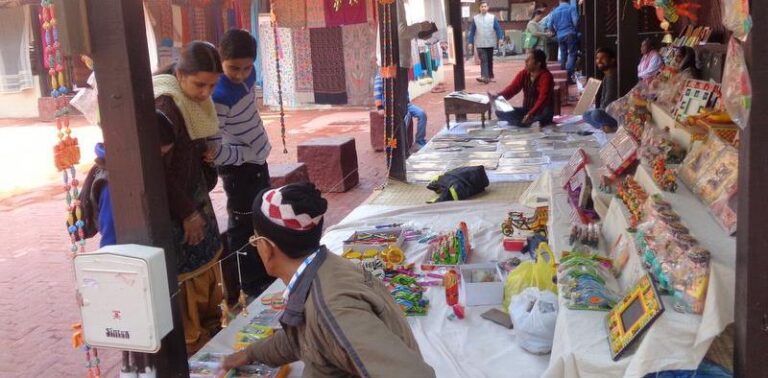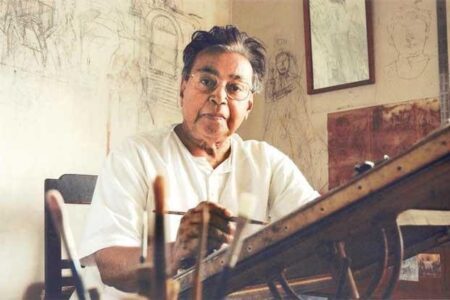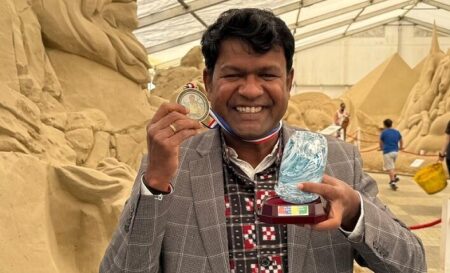The summer months are anyway lean season. Delhi’s Crafts Museum and Hastakala Academy is waiting for a post-Covid pickup
In the balmy spring days of this year, the National Crafts Museum in Delhi celebrated March as a Women Empowerment Month. Subsequently, though, the complex showcasing ethnic beauties of Indian handwork went into a lull. Reason: Covid-19.
The capital city is waiting for the pandemic to subside for activities to pick up in the five acres of the complex. An eco-friendly set-up conceived by social reformer Kamaladevi Chattopadhyay in a decade after Independence and spruced up majorly in the early 1990s by architect Charles Correa.
Founded in 1956, the five-acre museum houses three segments which overall feature around 34,000 objects. They chiefly comprise handicrafts, paintings, figurines, textiles and curios from the length and breadth of the country. The focus, naturally, is a tribal culture.
So impressed was a recent American visitor that he said Crafts Museum was a “terrible name”, given the place had much more to it. With its 15 life-size abodes of ethnicity representing a whole range of the country’s peoples along with their architectural beauty and craftsmanship, the museum often hosts folk music and dances. With its shops selling stuff right from trinkets to materials high on heritage value, the museum is a “delightful oasis”, the westerner notes in February 2020, as per a travel website.
The museum has five galleries, the most fascinating among them could be textile and folk art and cult craft. Besides, a small indoor theatre that screens documentaries on the country’s crafts and textile heritage. The café teems with visitors, more so during weekends when the footfalls often hit close to 2,500. Live crafts demonstrations are a regular feature what with a set of artists from some part of the country presenting shows for a fixed number of days and exit, only for a new team to take over space.
The artisans at the museum make their items right there and sell them. “It’s great to interact with them and spend time watching how they create their masterpiece,” says a young visitor.
Interestingly, the museum’s village complex is an extension of a temporary exhibition the administration held by the same name in 1972. Even as that show ended, some of the structures were not pulled down; what’s more, new structures cropped up down the course.
Five years ago, the museum was in the news for the wrong reasons. A section of the media quoted official sources and said the museum was poised to close down permanently so as to pave way for the installation of a complex solely for handicrafts. The Textiles Ministry, which owns the museum, subsequently refuted the claim and came up with some pleasant clarification: the museum will actually be getting a Hastakala Academy.
For all its splendour and variety, the museum doesn’t earn the deserving reputation. “This place has very few visitors. It seems people don’t know about it. Bureaucrats, ambassadors, art lovers and their families and friends are the only ones who visit this beautiful marvel,” sighs Stuti K, a visitor in June 2018.
True. Mostly, the discerning visitor alone reaches the place, only to be left surprised and attracted by the old-world ambience. Correa has “succeeded in making the museum almost invisible”, according to veteran cultural historian Jyotindra Jain. He in all praise for Correa while saying the architect “creates an environment that is difficult to define or label”. The museum, Dr Jain notes in a 1995 essay, “is not institutional and is deliberately self-effacing in its relationship to its ancient neighbour, the Purana Quila.” That is the grand and sprawling Old Fort, the rudiments of which dates to pre-Mauryan period. “Nor does it overshadow the artists’ village complex alongside.”
The brand-new Hastakala Academy intends to preserve, revive and document the country’s handloom/ handicraft sector, according to top officials. It nurtures the two traditions and promotes research besides conducting courses in subjects such as puppetry, terracotta, paintings (Gond and Madhubani), bamboo craft, weaving and block-printing.
The museum is growing.
Write to us at [email protected]




